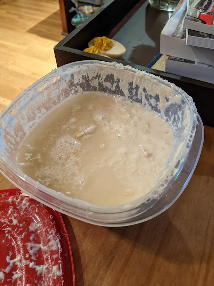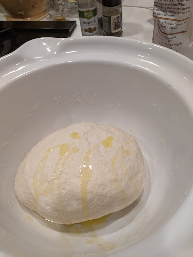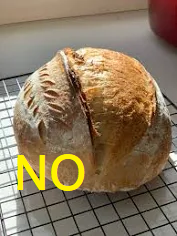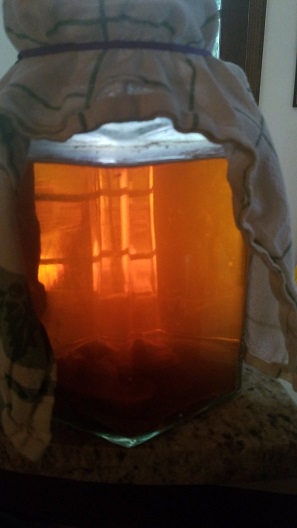This is the true story of what happened when we tried sourdough. It is unusual for us to give up on something before we’ve succeeded at it. In this case, we decided that we have bigger fish to fry, at the Firefly, Bed and Breakfast near Madison GA.
Back Story
As everybody knows, we’ve always got one or more projects going on at a time. In this case, we tried to produce some sourdough. Sourdough is of course the delightful tangy tasting bread that we like sometimes. The bread historians will tell you that sourdough is probably the earliest form of leavening bread. In North America this became sort of a go-to bread for the early settlers in the West, and reached the height of its popularity during the California gold rush.
How Bread Works
Just to bring you up to speed: You have a microorganism, namely yeast. You feed it some flour and sugar, and after awhile the microorganism eats it, and produces a by-product you like, namely the little holes that make the bread light and flavorful.
That way it becomes delightfully edible rather than hard as a brick.
Unleavened bread is a thing. But as long as we’re eating bread we prefer it to be nice and fluffy with a chewy crust.
How Sourdough Works
Instead of yeast, sourdough uses a bacteria, Lactobacillus. This delightful bacteria does the same job, minus the sugar. It produces the little bubbles, which are a greenhouse gas, using only the flour.
The “catch” as it were is that you are responsible for maintaining a life form. This is a “starter” that is a little container of bacteria. In a given loaf, you only use half of the starter. You keep the other half around, “alive”, until you’re ready to make the next batch.
So when you sign up for sourdough, you’re committed to keeping a little bacterial culture alive. That’s drawback number one, commitment. You have to feed it every few days or it’ll eat its food source and starve.
What Happened When we Tried Sourdough–The Sourdough Starter

Here it is. We got ours from someone in the parking lot of Tractor Supply. Among the sourdough people, this is sort of a religious thing. Some families have kept their sourdough starter alive through several generations.
The oldest living sourdough starter is in San Francisco, where it has been regenerated since 1849.
The sourdough starter is “fed” by dumping a cup full of flour into it. Once the bacteria start rocking and rolling, you then split it into two, and use half of it and discard half. That way the colony has a consistent food source.
That’s the second drawback. We couldn’t really stand the idea of throwing out something that was alive. One option would have been to split it every few days and keep both halves, but according to math, this would have led to exponential starter growth and we could see a problem with that idea.
Sourdough Production
You are supposed to take the sourdough starter, feed it, and as soon as it gets rocking and rolling, put flour into it and knead it and let it rise.
How do you know it’s rocking and rolling? You break off a little piece and put it into a glass of water to see if it floats. The delightful greenhouse gas that is emitted will cause the batch to float.
Here’s a video of what “not ready” looks like.
Sourdough Rising
Once you make the determination that your starter is ready, you add in a few cups of flour (the standard recipe calls for about four cups). You may then bring the batch together in the normal way for bread. Then, you need to let it rise using constant temperature.
At that point there is something that is called “autolyze”. You allow it to rest for 30 minutes to 1 hour for the bacteria to start to convert the gluten.
Here is drawback number three. No two sourdough starters is the same, and they are highly sensitive to conditions. Furthermore, you have to have in your schedule some time to allow this to happen.
Once that is done, you knead it down and allow for the actual “rising step.” That’s also temperature dependent. The sourdough batch doubles in size, and at that point it’s bakeable.
Here’s a Video Link
Shaping and Baking
At this point, there is an additional shaping step. The dough is split into two loaves, it is often shaped in a specific way to form the crusty crust. At that point, it is put into a ceramic bowl or baking pan, and allowed to rise another time.
Here is drawback #4, you have to come back to it after an hour to do this. This type of bread obviously requires a lot of nurturing time.

Baking
After the second rise, you score the top of the loaf so as to vent the gases when the bread bakes, and then put covered into a 425 degree oven. After about 20 minutes, you come back to remove the cover, at which point the crusty crust is supposed to form.
You continue to bake for another 40 minutes, at which point you need to come back to take it out of the oven.
That’s drawback number five. You have to come back to it again.

What could possibly go wrong?
Well, if you are responsible for entertaining a big house full of Europeans or Californians, you can’t always come back to tend your sourdough. If you are starting to nurture chicks, tend to the needs of converters, or otherwise have stuff going on, it is also not on your to-do list to wake up and feed your bacteria.
This would be perfect for someone in a big restaurant in California whose job it is to do nothing but tend to the famous sourdough.
Also, in our opinion this is dependent a lot on experience. You need to be able to look at the batch, decide that it needs more or less time, and act accordingly. This is the kind of thing a mother figure in your life would teach us how to do. At some point, we might retry. The first batch of this stuff came out like a brick. The chickens kind of liked it though.

Suggestion: Sourdough Workshop
We might even sponsor a sourdough workshop somewhere. Some sourdough expert could come in, and teach us and a happy group of people how to make the sourdough. This is the kind of thing the Levity Farms people should do, and we could do a good job on it as well.
What Happened When we Tried Sourdough–Do Over
So would we try this again? We might at some point when we have the proper motivation. For now, we will go to the Patisserie or the Roe and buy some if we want to.
What we did find out is that lactobacillus, the bacteria that causes all this is also sometimes the bacteria that is used to make kombucha. The “scoby” is a little life form that also contains yeast. But, in that case, all you have to do with it is nothing and it will keep itself alive.
So, we’re all over that. Starting something and walking away and coming back to find something wonderful is more our speed.
We’ll do a blog post on kombucha at some other point.

Links and References
The Clever Carrot
https://www.theclevercarrot.com/2014/01/sourdough-bread-a-beginners-guide/
Science Direct
Oldest Sourdough Starter
https://a-z-animals.com/blog/the-oldest-sourdough-starter-still-in-use-today/
Kombucha
![]()
